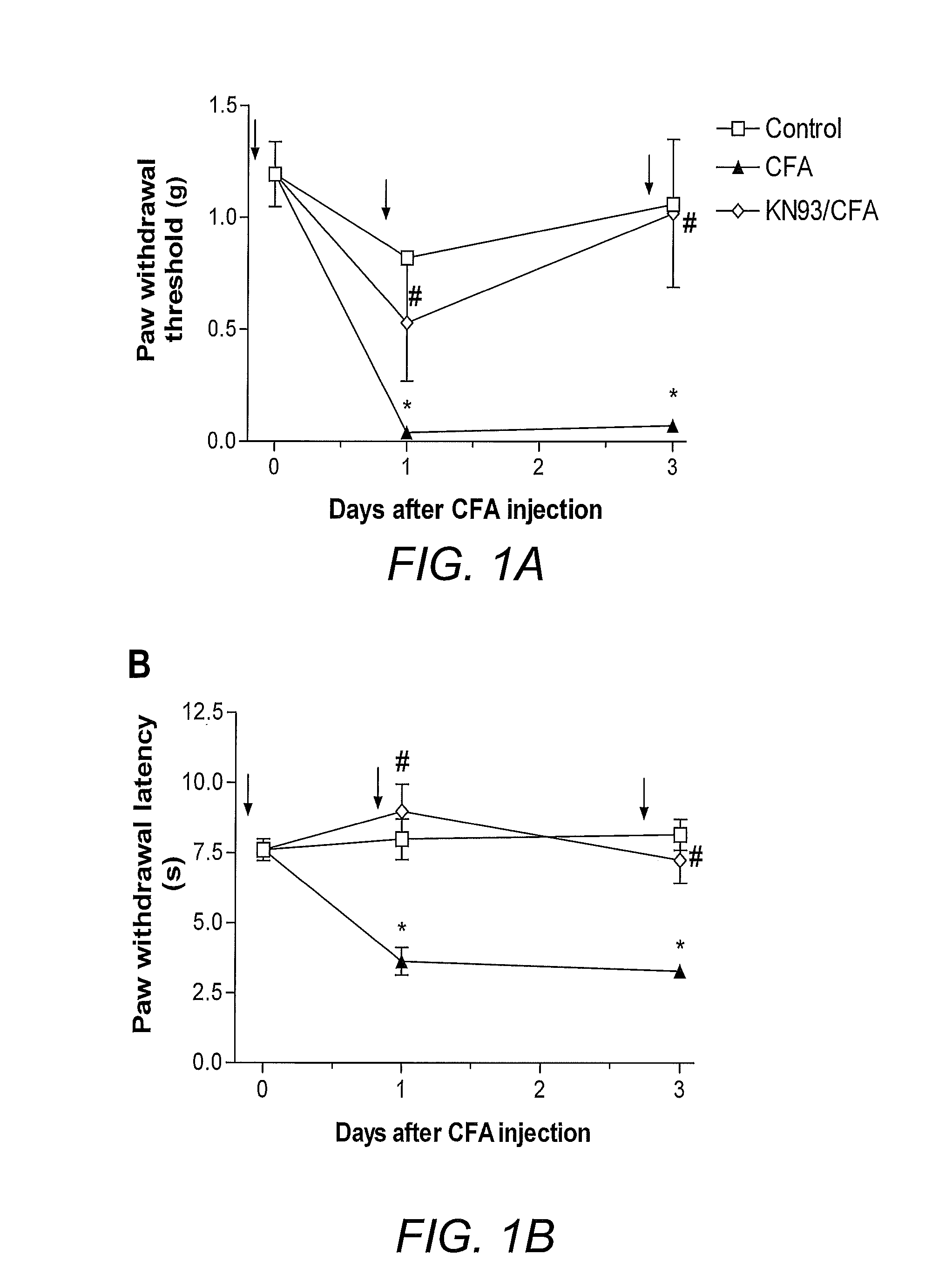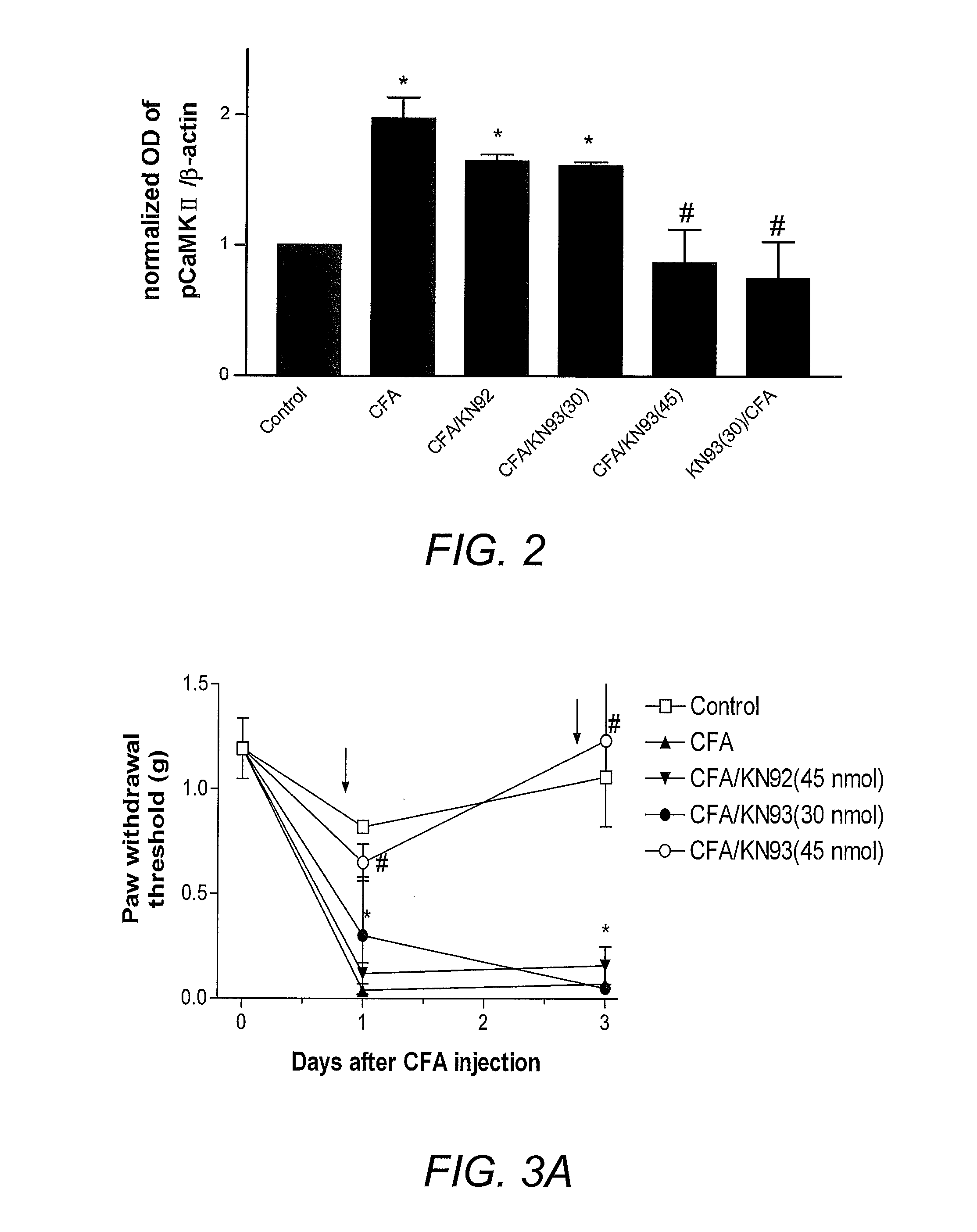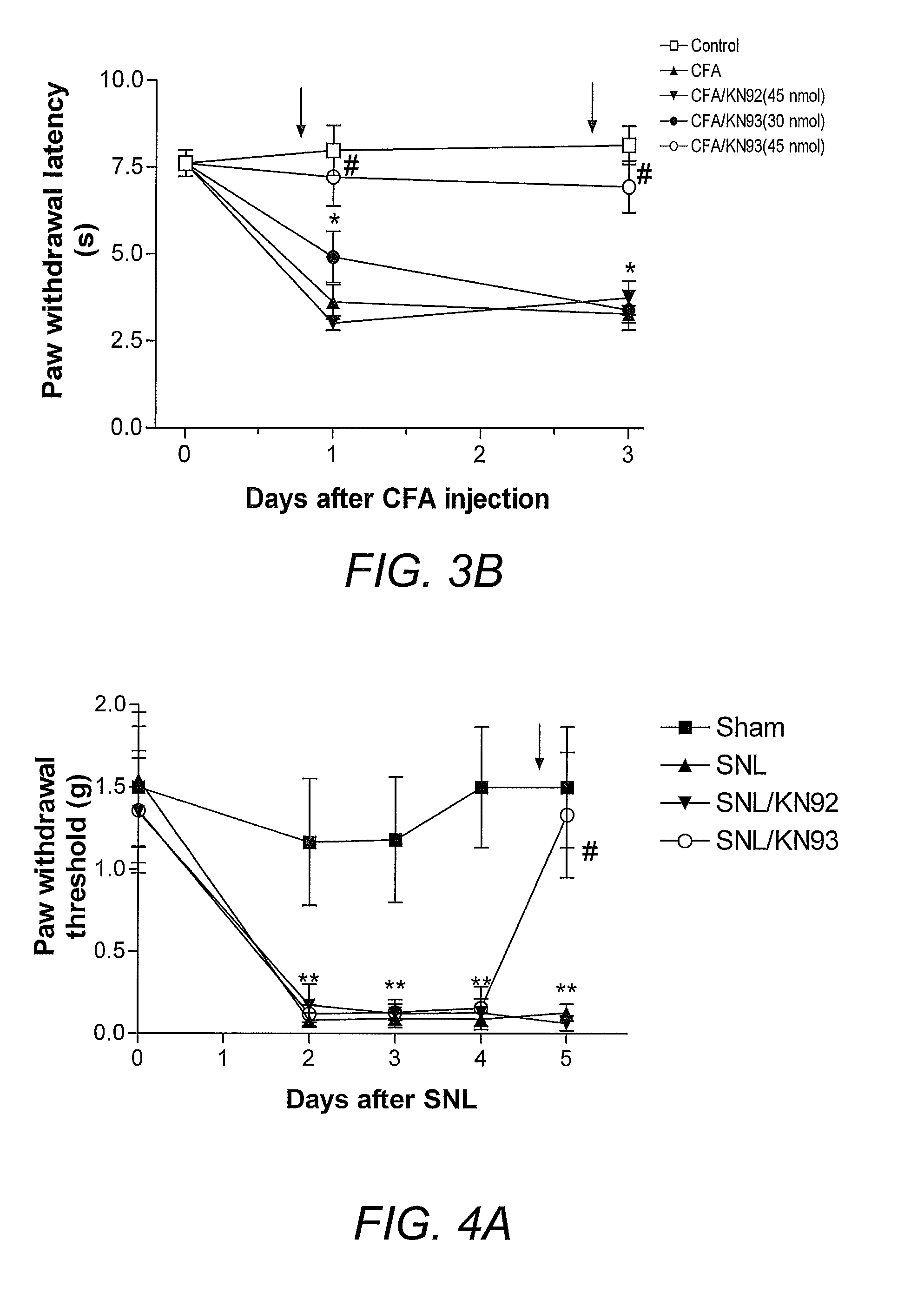Method for Treating Pain with a Calmodulin Inhibitor
a calmodulin inhibitor and pain technology, applied in the direction of enzymology, peptide/protein ingredients, transferases, etc., can solve the problems of increased side effects, frequent dose escalation, inadequate control of pain, etc., to prevent or treat pain, reverse, or prevent tolerance to an opiate analgesic
- Summary
- Abstract
- Description
- Claims
- Application Information
AI Technical Summary
Benefits of technology
Problems solved by technology
Method used
Image
Examples
example 1
Materials and Methods
[0070]Materials. Complete Freund's adjuvant (CFA, 1 mg / ml Mycobacterium tuberculosis (H 37RA, ATCC 25177, Heat killed and dried) and Trifluoperazine were purchased from Sigma (St. Louis, Mo.). KN93 [2-[N-(2-hydroxyethyl)]-N-(4-methoxybenzenesulfonyl)]amino-N-(4-chlorocinnamyl)-N-methylbenzylamine)] and KN92 [2-[N-(4-methoxybenzene-sulfonyl)]amino-N-(4-chlorocinnamyl)-N-methylbenzylamine] were from Calbiochem (Gibbstown, N.J.). Morphine sulfate, morphine and placebo pellets were obtained from the National Institute on Drug Abuse (Rockville, Md.). Protease inhibitor Cocktail Tablets were from Roche Diagnostics (Mannheim, Germany). Haloperidol, naloxone and all the other chemical reagents were from Sigma (St. Louis, Mo.).
[0071]Cell Lines. Human neuroblastoma SH-SY5Y cells were maintained as a monolayer culture in Dulbecco's Modified Eagle Medium (DMEM) supplemented with 10% fetal calf serum, 100 μg / ml streptomycin and 100 units / ml penicillin in 5% carbon dioxide wi...
example 2
Prevention and Treatment of Pain with KN93
[0096]To illustrate the involvement of the CaMKII signaling pathway in pain, CaMKII inhibitors were employed in a rat model of inflammatory pain and mouse model of neuropathic pain. Intraplantar injection of complete Freund's adjuvant (CFA) into the rat hind paw to induce inflammation has been used as a reliable animal model of inflammatory pain (Iadarola, et al. (1988) Pain 35(3):313-26). For neuropathic pain, a spinal nerve ligation model (SNL; Kim and Chung (1992) Pain 50(3):355-63) is widely accepted. Thermal hyperalgesia and mechanical allodynia have been shown in many studies to develop after CFA injection (Iadarola, et al. (1988) supra) or SNL (Kim and Chung (1992) supra; Wang, et al. (2001) J. Neurosci. 21(5):1779-86). Consistent with the prior art, CFA-treated mice demonstrated significantly reduced withdrawal latency to radiant heat and decreased withdrawal threshold to von Frey filaments within 24 hours and 72 hours (FIGS. 1A and ...
example 3
Treatment of Pain with Anti-Psychotics which Inhibit CaMKII
[0100]As indicated herein, trifluoperazine is a potent CaMKII inhibitor. As with KN93, trifluoperazine (0.5 mg / kg, i.p.) also completely reversed mechanical allodynia (FIG. 6A) and thermal hyperalgesia (FIG. 6B) induced by CFA (P<0.001 compared with the CFA group, N=8). At a lower dose (0.25 mg / kg, i.p.), trifluoperazine exhibited a partial effect in alleviating mechanical allodynia (P<0.05 compared with the CFA group, N=8). At an even lower dose (0.1 mg / kg, i.p.), this drug had no effect on CFA-induced hyperalgesia or allodynia (FIG. 6).
[0101]Similar to KN93, trifluoperazine (0.5 mg / kg, i.p., Day 5) also completely reversed established SNL-induced mechanical allodynia (P0.05 compared with the pre-drug baseline, N=12). These data indicate that trifluoperazine dose-dependently reverses CFA- and SNL-induced thermal hyperalgesia and tactile allodynia.
[0102]To demonstrate the general applicability of targeting the CaMKII signali...
PUM
| Property | Measurement | Unit |
|---|---|---|
| volume | aaaaa | aaaaa |
| length | aaaaa | aaaaa |
| volume | aaaaa | aaaaa |
Abstract
Description
Claims
Application Information
 Login to View More
Login to View More - R&D
- Intellectual Property
- Life Sciences
- Materials
- Tech Scout
- Unparalleled Data Quality
- Higher Quality Content
- 60% Fewer Hallucinations
Browse by: Latest US Patents, China's latest patents, Technical Efficacy Thesaurus, Application Domain, Technology Topic, Popular Technical Reports.
© 2025 PatSnap. All rights reserved.Legal|Privacy policy|Modern Slavery Act Transparency Statement|Sitemap|About US| Contact US: help@patsnap.com



